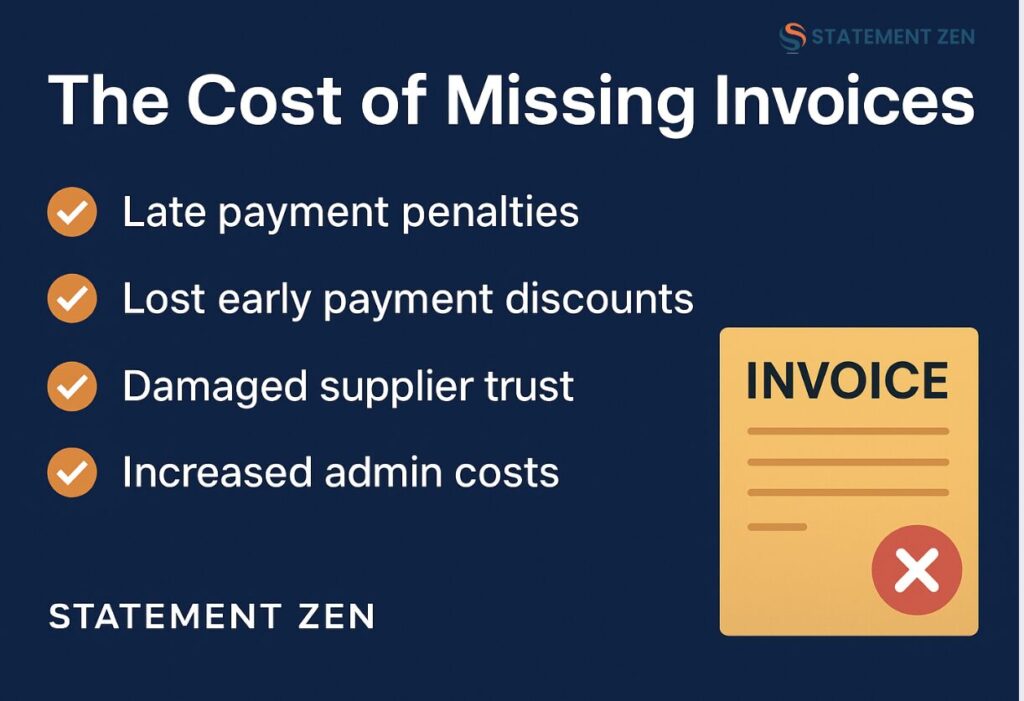If you’re running an accounts payable (AP) department, missing invoices are more than just an annoyance — they’re a silent, consistent drain on your time, cash flow, and supplier relationships. It’s not the kind of problem that shows up in one dramatic moment; it’s the small, repeated leaks that slowly sink the ship.
The truth? Missing invoices happen to almost every AP team. Whether they’re lost in transit, stuck in someone’s inbox, or never sent at all, they can easily slip through the cracks. And without a structured statement audit process in place, those cracks get bigger.
This guide will break down the true cost of missing invoices, why they happen, and how statement audits — paired with effective statement reconciliation — can seal the leaks for good.

The Real Cost of Missing Invoices
Most AP teams underestimate the damage missing invoices cause. They think, “We’ll catch it next month,” but by then, the fallout has already started.
Here’s what missing invoices are really costing you:
- Late Payment Penalties – Missed payment deadlines lead to interest charges or penalty fees.
- Lost Early Payment Discounts – Paying early can yield 1–2% savings, but only if the invoice is in the system on time.
- Damaged Supplier Trust – Late or inconsistent payments signal operational inefficiency. Suppliers start tightening terms or demanding prepayment.
- Increased Admin Costs – Chasing down missing documents is a manual, resource-heavy process.
- Reconciliation Discrepancies – Every missing invoice is a mismatch waiting to derail your month-end close.
Why Missing Invoices Happen
Understanding the root cause is the first step toward fixing it.
1. Invoices Sent to the Wrong Person or Department
Without a centralized intake process, invoices can get lost in internal forwarding chains.
2. Spam Filters and Email Overload
Digital invoices are often buried in cluttered inboxes or filtered into junk folders.
3. Paper Mail Bottlenecks
In the age of hybrid work, paper invoices still arrive — and get delayed on desks or in mailrooms.
4. Lack of Supplier Compliance
Some suppliers fail to follow your submission guidelines, sending invoices in inconsistent formats or via unofficial channels.
The Role of Statement Audits in Fixing the Problem

A statement audit is your safety net. Instead of just checking if your balance matches the supplier’s, it verifies every invoice, credit note, and payment on their statement against your AP records.
The key here is transaction-level validation — not just balance checks. This means:
- Identifying invoices that are missing from your system entirely
- Catching unapplied supplier credits before they expire
- Detecting duplicate invoices that could slip through standard checks
- Confirming that payments were allocated correctly
When done monthly or quarterly, statement audits turn what was once a reactive scramble into a proactive control measure.
Supplier Matching: Your First Line of Defense
Statement audits work best when paired with robust supplier matching practices. This process ensures:
- Every invoice in your ledger has a corresponding supplier record
- Credits are fully and accurately applied
- Payments are recorded identically in both systems
- Discrepancies are tracked, resolved, and prevented from recurring
By tightening supplier matching, you not only prevent missing invoices but also create cleaner reconciliation cycles.
From Reconciliation Discrepancies to Full Control
Reconciliation discrepancies are often the symptom — missing invoices are the disease. If your AP ledger and supplier statement don’t match, you’re either missing invoices, missing credits, or both.
A consistent statement reconciliation process ensures that:
- Every supplier statement is reviewed systematically
- Discrepancies are flagged and addressed immediately
- No invoice gets left out of the payment cycle
- You can close your books faster and with fewer adjustments
How Automation Changes the Game
Manual statement audits are effective — but they’re also slow, prone to human error, and unsustainable at scale. This is where automation comes in.
Automated statement matching software can:
- Pull supplier statements directly from email or portals
- Cross-check every line item against your AP ledger in seconds
- Flag missing invoices instantly
- Provide a clear exception list for your team to action
The result? Faster audits, fewer missed invoices, and month-end closes that run on schedule — without sacrificing accuracy.
Building a Missing Invoice Prevention Framework
To eliminate missing invoices for good, combine process discipline with automation. Here’s a framework you can implement:
- Centralize Invoice Intake
All invoices should be sent to a single, monitored address or portal. - Automate Logging on Receipt
Every invoice should be recorded — even before verification — so it can’t be forgotten. - Run Monthly Statement Audits
Compare every supplier statement against your ledger at the transaction level. - Resolve Discrepancies Immediately
The longer you wait, the harder they are to fix. - Track and Report Metrics
Monitor how many missing invoices you find each cycle — and aim to reduce the number over time.
The ROI of Fixing Missing Invoices
Let’s put numbers to it. Imagine your team processes 2,000 invoices a month:
- If even 2% go missing (40 invoices), and the average invoice value is $1,000, that’s $40,000 at risk each month.
- Recovering just half of those through audits means $20,000 saved.
- Add early payment discounts of 1% on $500,000 in eligible invoices, and you gain another $5,000.
That’s $25,000/month in potential savings — or $300,000 a year.
FAQ – Missing Invoices and Statement Audits
Q: How often should I run a statement audit?
Monthly is ideal, but at minimum, conduct them quarterly to catch and correct discrepancies before year-end.
Q: Can automation completely eliminate missing invoices?
No system is perfect, but automation drastically reduces the volume and speeds up resolution.
Q: What’s the difference between statement reconciliation and a statement audit?
Reconciliation checks balances; a statement audit verifies every transaction.
Q: How does supplier matching help with missing invoices?
It ensures your AP records align with the supplier’s records, making missing invoices easier to detect.
Final Word: From Firefighting to Prevention
Missing invoices will always try to sneak into your workflow — but with the right processes, you can catch them before they cost you. A disciplined statement audit process, reinforced by automation and supplier matching, transforms AP from a reactive, error-prone function into a proactive, value-protecting powerhouse.
In other words: stop playing catch-up. Start taking control.
